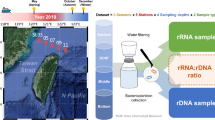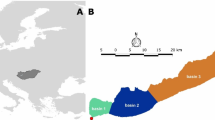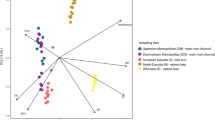Abstract
To understand the mechanisms determining community composition, it is essential to distinctively unravel the importance of local from that of regional processes. In this effort, the mechanisms underlying bacterioplankton community assembly were analysed in eight lakes of short water residence time (WRT) during a four-season sampling campaign. Bacterioplankton community composition (BCC) was determined using terminal-restriction fragment length polymorphism (t-RFLP) on the 16S rRNA gene (16S rDNA) and 16S rRNA. The relationship between similarity in BCC between a lake and its major inlet on the one hand and cell import per cell production rate from the inlet to the lake epilimnion on the other was used as a measure of the importance of cell dispersal (mass effects) for community assembly. Low similarities in BCC between lakes and their inlets were observed even at short WRTs, and the degree of similarity correlated better with the environmental conditions in lakes and streams than with cell import per cell production rates. Thus, mass effects seemed less important for local lake BCC in comparison to environmental habitat characteristics (species sorting). Analyses of 16S rDNA and 16S rRNA community fingerprints yielded similar results, indicating that species-sorting dynamics exerted an equally important effect on both the abundant and active fraction within the studied bacterioplankton communities.
Similar content being viewed by others
Log in or create a free account to read this content
Gain free access to this article, as well as selected content from this journal and more on nature.com
or
References
Bell RT . (1990). An explanation for the variability in the conversion factor deriving bacterial-cell production from incorporation of [h-3] thymidine. Limnol Oceanogr 35: 910–915.
Bell RT . (1993). Estimating production of heterotrophic bacterioplankton via incorporation of tritiated thymidine. In: Kemp PF, Sherr BF, Sherr EB, Cole JJ (eds). Handbook of Methods in Aquatic Microbial Ecology. Lewis Publishers: London, pp 495–503.
Bremer H, Dennis PP . (1987). Modulation of chemical composition and other parameters of the cell by growth rate. In: Neidhardt FC, Ingraham JL, Low B, Magasanik B, Schaechter M, Umbarger HE (eds). Escherichia coli and Salmonella Typhimurium: Cellular and Molecular Biology. American Society of Microbiology: Washington DC, pp 1527–1542.
Brunberg A-K, Blomqvist P . (1998). Vatten i Uppsala län 1997. Upplandsstiftelsen: Uppsala, Sweden.
Choi JW, Sherr EB, Sherr BF . (1996). Relation between presence absence of a visible nucleoid and metabolic activity in bacterioplankton cells. Limnol Oceanogr 41: 1161–1168.
Clements FE . (1916). Plant Succession. An Analysis of the Development of Vegetation vol. 242, Carnegie Institute Washington Publication.
Connor EF, Simberloff D . (1979). The assembly of species communities—chance or competition. Ecology 60: 1132–1140.
Cottenie K . (2005). Integrating environmental and spatial processes in ecological community dynamics. Ecol Lett 8: 1175–1182.
Crump BC, Hopkinson CS, Sogin ML, Hobbie JE . (2004). Microbial biogeography along an estuarine salinity gradient: combined influences of bacterial growth and residence time. Appl Environ Microbiol 70: 1494–1505.
Crump BC, Adams HE, Hobbie JE, Kling GW . (2007). Biogeography of bacterioplankton in lakes and streams of an arctic tundra catchment. Ecology 88: 1365–1378.
del Giorgio PA, Gasol JM . (2008). Physiological structure and single-cell activity in marine bacterioplankton. In: Kirchman DL (ed). Microbial Ecology of the Oceans 2nd edn. Wiley: Hoboken, New Jersey, USA, pp 243–298.
del Giorgio PA, Scarborough G . (1995). Increase in the proportion of metabolically active bacteria along gradients of enrichment in fresh-water and marine plankton—implications for estimates of bacterial-growth and production-rates. J Plankton Res 17: 1905–1924.
del Giorgio PA, Prairie YT, Bird DF . (1997). Coupling between rates of bacterial production and the abundance of metabolically active bacteria in lakes, enumerated using CTC reduction and flow cytometry. Microb Ecol 34: 144–154.
Diamond JM . (1975). Assembly of species communities. In: Cody ML, Diamond JM (eds). Ecology and Evolution of Communities. Harvard University Press: Cambridge, MA, pp 342–444.
Gleason HA . (1926). The individualistic concept of the plant association. Bull Torrey Bot Club 53: 7–26.
Hammer Ø, Harper DAT, Ryan PD . (2001). PAST: paleontological statistics software package for education and data analysis. Palaeontol Electr 4: 9–11.
Harrison S, Cornell H . (2008). Toward a better understanding of the regional causes of local community richness. Ecol Lett 11: 969–979.
Hobbie JE, Daley RJ, Jasper S . (1977). Use of nuclepore filters for counting bacteria by fluorescence microscopy. Appl Environ Microbiol 33: 1225–1228.
Holyoak M, Leibold MA, Holt RD . (2005). Metacommunities: Spatial Dynamics and Ecological Communities. The University of Chicago Press: Chicago and London.
Hoshino YT, Matsumoto N . (2007). DNA- versus RNA-based denaturing gradient gel electrophoresis profiles of a bacterial community during replenishment after soil fumigation. Soil Biol Biochem 39: 434.
Hubbell SP . (2001). The Unified Neutral Theory of Biodiversity and Biogeography. Princeton University Press: Princeton, NY.
Jespersen AM, Christoffersen K . (1987). Measurements of chlorophyll-a from phytoplankton using ethanol as extraction solvent. Arch Hydrobiol 109: 445–454.
Jones SE, McMahon KD . (2009). Species-sorting may explain an apparent minimal effect of immigration on freshwater bacterial community dynamics. Environ Microbiol 11: 905–913.
Lane DJ, Pace B, Olsen GJ, Stahl DA, Sogin ML, Pace NR . (1985). Rapid-determination of 16s ribosomal-RNA sequences for phylogenetic analyses. Proc Natl Acad Sci USA 82: 6955–6959.
Langenheder S, Ragnarsson H . (2007). The role of environmental and spatial factors for the composition of aquatic bacterial communities. Ecology 88: 2154–2161.
Legendre P, Legendre L . (1998). Numerical Ecology. Elsevier: Amsterdam, The Netherlands.
Leibold MA, Holyoak M, Mouquet N, Amarasekare P, Chase JM, Hoopes MF et al. (2004). The metacommunity concept: a framework for multi-scale community ecology. Ecol Lett 7: 601–613.
Lindström ES, Forslund M, Algesten G, Bergström AK . (2006). External control of bacterial community structure in lakes. Limnol Oceanogr 51: 339–342.
Liu WT, Marsh TL, Cheng H, Forney LJ . (1997). Characterization of microbial diversity by determining terminal restriction fragment length polymorphisms of genes encoding 16S rRNA. Appl Environ Microbiol 63: 4516–4522.
Logue JB, Lindström ES . (2008). Biogeography of bacterioplankton in inland waters. Freshwater Rev 1: 99–114.
Mahmood S, Prosser JI . (2006). The influence of synthetic sheep urine on ammonia oxidizing bacterial communities in grassland soil. Fems Microbiol Ecol 56: 444–454.
Martiny JBH, Bohannan BJM, Brown JH, Colwell RK, Fuhrman JA, Green JL et al. (2006). Microbial biogeography: putting microorganisms on the map. Nat Rev Microbiol 4: 102–112.
Menzel DH, Corwin N . (1965). The measurement of total phosphorus in seawater based on the liberation of organically bound fractions by persulfate oxidation. Limnol Oceanogr 10: 280–282.
Murphy J, Riley JP . (1962). A modified single solution method for the determination of phosphate in natural waters. Anal Chim Acta 27: 31–26.
Nelson CE, Sadro S, Melack JM . (2009). Contrasting the influences of stream inputs and landscape position on bacterioplankton community structure and dissolved organic matter composition in high-elevation lake chains. Limnol Oceanogr 54: 1292–1305.
Peres-Neto PR, Legendre P, Dray S, Borcard D . (2006). Variation partitioning of species data matrices: estimation and comparison of fractions. Ecology 87: 2614–2625.
R (2008). R: A Language and Environment for Statistical Computing. R Foundation for Statistical Computing: Vienna, Austria.
Ricklefs RE . (1987). Community diversity—relative roles of local and regional processes. Science 235: 167–171.
Rodriguez-Blanco A, Ghiglione JF, Catala P, Casamayor EO, Lebaron P . (2009). Spatial comparison of total vs active bacterial populations by coupling genetic fingerprinting and clone library analyses in the NW Mediterranean Sea. Fems Microbiol Ecol 67: 30–42.
Schaechter M, Maaloe O, Kjeldgaard NO . (1958). Dependency on medium and temperature of cell size and chemical composition during balanced growth of Salmonella typhimurium. J Gen Microbiol 19: 592–606.
Schäfer H, Bernard L, Courties C, Lebaron P, Servais P, Pukall R et al. (2001). Microbial community dynamics in Mediterranean nutrient-enriched seawater mesocosms: changes in the genetic diversity of bacterial populations. Fems Microbiol Ecol 34: 243–253.
Sherr EB, Sherr BF, Sigmon CT . (1999). Activity of marine bacteria under incubated and in situ conditions. Aquat Microb Ecol 20: 213–223.
Teske A, Wawer C, Muyzer G, Ramsing NB . (1996). Distribution of sulfate-reducing bacteria in a stratified fjord (Mariager fjord, Denmark) as evaluated by most-probable-number counts and denaturing gradient gel electrophoresis of PCR-amplified ribosomal DNA fragments. Appl Environ Microbiol 62: 1405–1415.
Troussellier M, Schafer H, Batailler N, Bernard L, Courties C, Lebaron P et al. (2002). Bacterial activity and genetic richness along an estuarine gradient (Rhone River plume, France). Aquat Microb Ecol 28: 13–24.
Van der Gucht K, Cottenie K, Muylaert K, Vloemans N, Cousin S, Declerck S et al. (2007). The power of species sorting: Local factors drive bacterial community composition over a wide range of spatial scales. Proc Natl Acad Sci USA 104: 20404–20409.
Vergin KL, Urbach E, Stein JL, DeLong EF, Lanoil BD, Giovannoni SJ . (1998). Screening of a fosmid library of marine environmental genomic DNA fragments reveals four clones related to members of the order Planctomycetales. Appl Environ Microbiol 64: 3075–3078.
Villalva C, Touriol C, Seurat P, Trempat P, Delsol G, Brousset P . (2001). Increased yield of PCR products by addition of T4 gene 32 protein to the SMART (TM) PCR cDNA synthesis system. Biotechniques 31: 81–86.
Wilson DS . (1992). Complex interactions in metacommunities, with implications for biodiversity and higher levels of selection. Ecology 73: 1984–2000.
Yannarell AC, Triplett EW . (2005). Geographic and environmental sources of variation in lake bacterial community composition. Appl Environ Microbiol 71: 227–239.
Acknowledgements
We thank Sara Beier and Silke Langenheder for initial help with regard to RNA handling and Xinmei Feng for constructive discussions on t-RFLP analysis. We are thankful to Janne Johansson for assistance in the field and physico-chemical water and bacterial abundance analyses. We are indebted to Silke Langenheder, Lars Tranvik and three anonymous reviewers for constructive comments on the manuscript. The Swedish Meteorological and Hydrological Institute (SMHI) and the Department of Hydrology, Uppsala University, generously provided us with water flow data. This work was financed by grants from the Swedish Research Council (ESL).
Author information
Authors and Affiliations
Corresponding author
Rights and permissions
About this article
Cite this article
Logue, J., Lindström, E. Species sorting affects bacterioplankton community composition as determined by 16S rDNA and 16S rRNA fingerprints. ISME J 4, 729–738 (2010). https://doi.org/10.1038/ismej.2009.156
Received:
Revised:
Accepted:
Published:
Issue date:
DOI: https://doi.org/10.1038/ismej.2009.156
Keywords
This article is cited by
-
Local eukaryotic and bacterial stream community assembly is shaped by regional land use effects
ISME Communications (2023)
-
Bacterioplankton Assembly Along a Eutrophication Gradient Is Mainly Structured by Environmental Filtering, Including Indirect Effects of Phytoplankton Composition
Microbial Ecology (2023)
-
Terrestrial connectivity, upstream aquatic history and seasonality shape bacterial community assembly within a large boreal aquatic network
The ISME Journal (2022)
-
Rhizosphere microbiome dynamics in tropical seagrass under short-term inorganic nitrogen fertilization
Environmental Science and Pollution Research (2021)
-
How sediment bacterial community shifts along the urban river located in mining city
Environmental Science and Pollution Research (2021)



